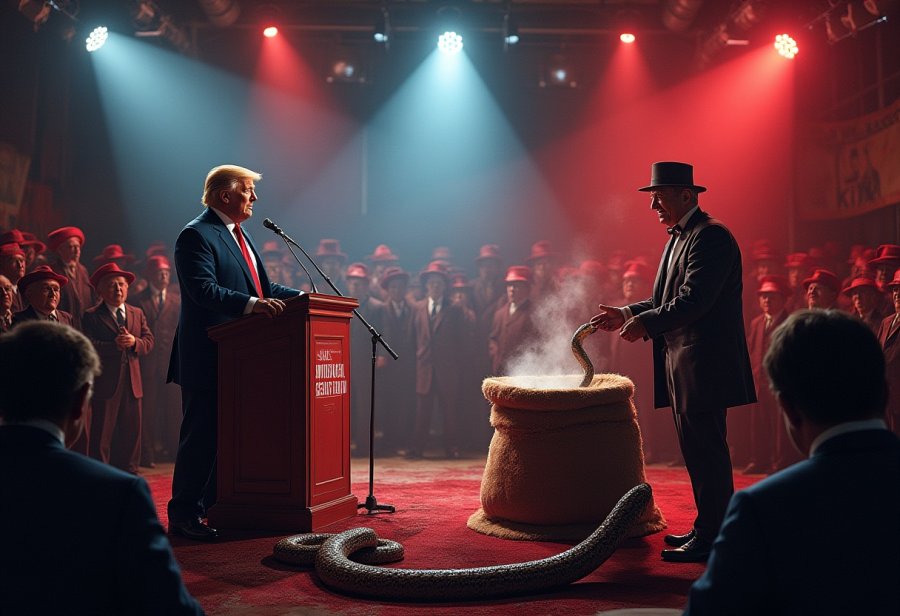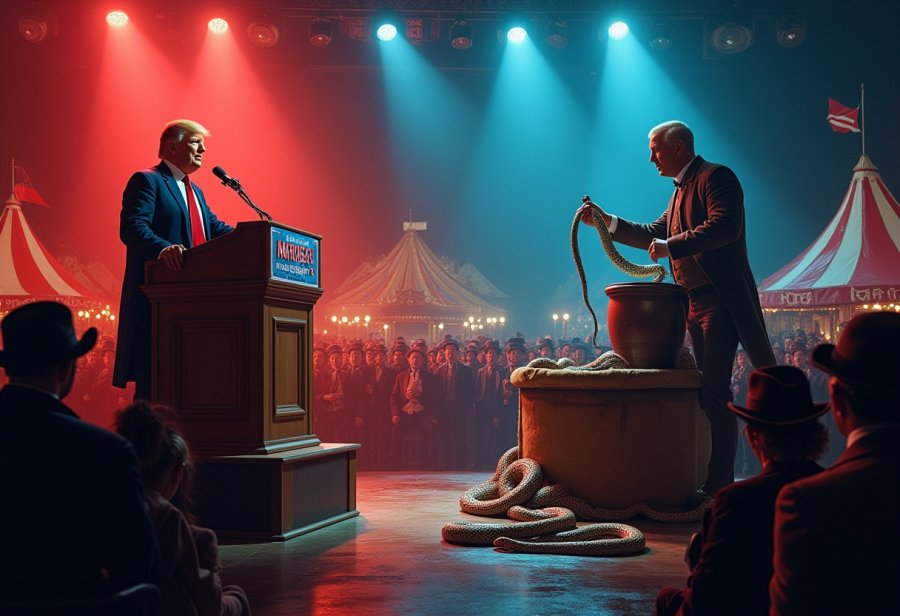Why are Americans so irresistibly drawn to charismatic leaders who promise simple solutions amidst chaos and complexity? This enduring fascination taps into deep psychological needs for certainty, belonging, and hope—traits that showmen from the snake oil salesmen of the 19th century to modern politicians like Donald Trump have mastered through spectacle and storytelling. These figures craft emotional experiences that transcend facts, offering quick fixes that often mask superficiality or deception. From the theatrical medicine shows of old to today’s raucous rallies, the core strategy remains the same: evoke strong feelings—hope, pride, fear—and forge bonds that override critical thinking. But what does this say about our collective psyche? Are we seeking genuine cures or merely comfort in illusions? Understanding this complex dynamic helps us recognize why our desire for straightforward answers is so powerful—and how it can both unite and deceive us in the pursuit of progress.

The Allure of Charismatic Leaders: Why We Crave Hope and Simplicity
In America, the allure of charismatic figures promising simple solutions to complex problems has been a recurring theme. From the rousing speeches of early political showmen to today’s high-energy rallies, our culture has long gravitated toward leaders who can deliver hope wrapped in spectacle. These figures understand that capturing attention isn’t just about facts; it’s about creating an experience that stirs emotions and fosters a sense of connection. Whether it’s a politician, a con artist, or a celebrity, their power lies in their ability to make us feel understood and hopeful.
This fascination raises a fundamental question: why are we so drawn to these personalities? One answer lies in our innate desire for certainty. When faced with the chaos and ambiguity of today’s world, simple promises can feel like a lifeline—quick fixes that cut through complexity and offer clear, digestible answers. Charismatic leaders craft messages that seem to promise immediate relief, even if the solutions are superficial or unrealistic. Their confidence and swagger make it easy for us to believe that the problems of a nation—or our lives—can be solved with a few easy steps.
Historical examples reveal that this isn’t a new phenomenon. In the 19th century, medicine shows used theatrical tricks and storytelling to sell cures. These performances blurred the line between science and entertainment, turning health advice into captivating spectacles. Similarly, political campaigns have long relied on rallying cries, memorable slogans, and larger-than-life personas to rally support. Both contexts show that persuasion often depends more on emotional engagement than on detailed evidence. The spectacle becomes the message, and the audience’s emotional response is what truly seals the deal.
The core of this appeal is rooted in our psychological makeup. Humans are social creatures, craving belonging and validation. Leaders who appear authentic, relatable, and aligned with shared values create bonds that go beyond logic. They tap into our hopes, fears, and cultural narratives, making us feel part of something bigger. These emotional connections often overshadow rational analysis, leading supporters to accept simplified narratives that reinforce their identity and worldview. It’s not just about the message—it’s about the feeling of being understood and protected.
This dynamic is reinforced by the power of storytelling and showmanship. Charismatic figures craft moments that evoke strong emotions—hope, pride, anger, or fear—and use spectacle to deepen these feelings. Whether it’s a rally full of chants or a theatrical demonstration, these moments create shared experiences that forge loyalty. They turn passive observers into active believers, eager to believe in the promise of a quick fix or a miracle cure. The spectacle becomes a symbol of hope, even when the substance behind it is flimsy or exaggerated.
Throughout American history, this pattern persists because it speaks to deep-seated needs. We want to believe that problems are solvable and that change is just around the corner. Leaders who understand this instinct use emotion and entertainment to bypass critical thinking, making their messages irresistibly compelling. The line between genuine leadership and spectacle often blurs, driven by a fundamental human craving for certainty, belonging, and hope. Recognizing this helps us understand why the allure of charismatic figures and simple solutions remains so strong, even in an age of information and skepticism.

From Medicine Shows to Modern Rallies: The Evolution of Showmanship in American Politics and Entertainment
The tradition of showmanship runs deep in American history, especially in the worlds of politics and entertainment. From the earliest days, leaders and performers understood that capturing an audience’s attention often depended more on spectacle and drama than on facts alone. Political rallies, for example, transformed into theatrical performances designed to stir emotions and create memorable impressions. Charismatic figures like William Jennings Bryan used fiery speeches and larger-than-life personas to rally support, turning campaigns into emotional experiences rather than just debates over policy. This approach made their messages resonate on a visceral level, forging a sense of connection that went beyond dry political talk.
Medicine shows of the 19th century exemplify this tradition vividly. These traveling entertainers relied heavily on storytelling, tricks, and dramatic demonstrations to sell their cures. The performances often featured pulling rattlesnakes from sacks, slicing open reptiles, and boiling mysterious ingredients—all designed to wow audiences and distract from the lack of scientific backing. These shows blurred the line between science and spectacle, turning health advice into entertainment and convincing many that quick fixes could be found in a bottle. The theatricality was as much about persuasion as it was about the product itself, making the entire process feel like a captivating event.
The power of showmanship in these contexts is strikingly similar to modern political rallies, where emotional engagement often trumps detailed policy discussions. Politicians like Theodore Roosevelt or William McKinley understood that stirring speeches and memorable slogans could galvanize support more effectively than facts alone. Today’s campaign events, with their chants, visual staging, and dramatic storytelling, continue this tradition. Whether it’s a fiery speech or a sweeping slogan, these moments create an immersive experience that taps into feelings of pride, anger, or hope—sometimes more than they communicate concrete solutions.
A prime example of this theatrical approach is Clark Stanley’s “Rattlesnake King” act at the 1893 World’s Columbian Exposition. Dressed as a frontier hero, Stanley performed a dramatic routine: pulling a rattlesnake from a sack, slicing it open, and boiling its fat to sell a supposed miracle cure. The performance was pure entertainment, designed to mesmerize the crowd and convince them that a bottle of snake oil could solve their health problems. While Stanley’s show wasn’t rooted in science, it demonstrated how spectacle and storytelling could turn a simple product into a powerful illusion—one that played on hopes for quick relief.
Interestingly, the story of snake oil itself has a twist. The original snake oil wasn’t fake; it was a legitimate remedy brought to America by Chinese railroad workers. Made from water snakes rich in omega-3s, it was used to treat arthritis and inflammation effectively, especially when rubbed on joints. Yet, the term “snake oil” has come to symbolize deception because of the proliferation of fake cures and exaggerated promises. The spectacle of selling quick fixes often disguises the reality that real healing takes time and effort—something that the flashy performances tend to overlook.
Modern figures like Donald Trump have revived this tradition, blending spectacle with emotional storytelling to build a loyal following. His rallies, much like Stanley’s medicine shows, are designed to generate a shared emotional experience. Promises like “Build the wall” or “Drain the swamp” function much like snake oil pitches—catchy slogans that evoke hope or fear and promise quick results. Supporters aren’t just buying policies; they’re buying a sense of identity, belonging, and the belief that their problems can be solved with a simple fix. This theatrical approach taps into a deep-rooted desire for certainty and control in a complex world.
Throughout American history, the pattern of using showmanship and spectacle to persuade has proven remarkably resilient. Leaders who understand the power of emotion and storytelling can sway public opinion far more effectively than those relying solely on facts. Whether it’s a frontier demonstration or a modern rally, the core strategy remains the same: craft moments that evoke strong feelings—hope, pride, or anger—and turn them into shared experiences. This approach transforms passive audiences into loyal followers, eager to believe in quick fixes and simple solutions, despite their often superficial or exaggerated nature.
The Psychological Roots of Attraction: How Biases and Identity Drive Support for Quick Fixes
People are naturally drawn to simple solutions and charismatic figures because our minds favor quick, clear answers over complex, uncertain realities. When faced with complicated problems, many of us seek certainty and control—things that simple promises seem to provide. Leaders who craft straightforward messages tap into this instinct, offering slogans or solutions that feel like immediate relief, even if they oversimplify or ignore the nuances of the issues. This tendency isn’t just about convenience; it’s rooted in how our brains process information and seek patterns to make sense of the world.
Support for these figures also stems from our social nature. Humans have an innate desire to belong and to feel part of something larger than themselves. When a leader appears authentic, relatable, and aligned with shared values, it fosters a sense of trust and community. This bond becomes even stronger if the leader’s message resonates emotionally, rather than just logically. Supporting someone who seems to understand our struggles offers validation and comfort—especially when their promises are exaggerated or superficial. It’s a quick way to feel understood and protected in a confusing environment.
Charismatic figures excel at showmanship, knowing that emotions like hope, pride, fear, and anger drive loyalty more than facts ever could. They craft moments—whether through speeches, rallies, or theatrical displays—that evoke these feelings intensely. These emotional experiences create a sense of shared purpose and identity, transforming passive supporters into engaged believers. The spectacle acts as a shortcut to their hearts, bypassing rational analysis and deepening the emotional bond. This strategy makes supporters more receptive to simplified narratives that reinforce their worldview, regardless of their factual accuracy.
Our susceptibility to simple solutions is also amplified by cognitive biases. The need for certainty makes us prefer quick fixes, while pattern recognition pushes us to find familiar solutions in unfamiliar situations. When leaders present ideas that fit neatly into our existing beliefs or cultural narratives, they seem even more trustworthy. The human tendency to seek coherence and avoid ambiguity makes us more receptive to charismatic figures who promise clarity amid chaos. These biases create a psychological environment ripe for influence, where emotional appeal often outweighs factual evidence.
Moreover, supporting these figures satisfies deeper psychological needs—belonging, validation, and hope. During times of uncertainty or crisis, people crave reassurance and a sense that everything will be okay. Leaders who understand this instinct craft messages that evoke strong feelings, making their promises feel personal and urgent. They create a narrative in which followers are part of a righteous cause, fighting against external threats or injustices. This sense of shared purpose and emotional connection becomes a powerful glue, binding supporters even when the promises are exaggerated or unrealistic.
Finally, the emotional engagement fostered by spectacle and storytelling often overshadows critical thinking. When leaders evoke strong feelings—whether through stirring speeches, dramatic visuals, or memorable slogans—they bypass our rational defenses. Supporters tend to accept these messages because they feel authentic and emotionally satisfying, not because they are scrutinized or verified. Recognizing this dynamic helps us understand why superficial appeals can be so persuasive and why deep skepticism can be hard to maintain in emotionally charged moments. It’s a reminder that beneath the surface of many charismatic appeals lies a fundamental human desire for certainty, connection, and hope—one that can be easily exploited when we’re most vulnerable.
Understanding these psychological dynamics can help us become more aware of how charisma and emotional appeals influence our perceptions. For those interested in exploring this topic further, the article on the psychology of identity and influence provides valuable insights into why we are so susceptible to these tactics, emphasizing the importance of critical thinking and self-awareness in navigating political and social narratives.

Understanding Our Fascination: Embracing Critical Thinking to Resist Charismatic Illusions
Americans’ fascination with charismatic leaders and simple solutions taps into fundamental psychological needs—our desire for clarity, reassurance, and control in a world that often feels overwhelming and unpredictable. We tend to believe that even the most complex problems can be solved with straightforward answers, which makes us especially receptive to figures who promise quick fixes. These leaders craft messages that evoke hope, pride, or fear, forging emotional bonds that often overshadow the importance of nuanced understanding or critical analysis.
Throughout history, this pattern has proved remarkably resilient. Whether in the form of fiery political orators, traveling medicine showmen, or modern populists, the core strategy remains the same: create moments of spectacle and storytelling that stir powerful emotions. These moments forge a sense of shared identity and purpose, transforming passive audiences into loyal followers eager to believe in easy solutions. The emotional appeal, often delivered through theatrical displays or memorable slogans, bypasses rational scrutiny and deepens the supporter’s attachment.
The appeal of simple solutions is driven by more than just a desire for convenience; it reflects deep-seated psychological instincts. When faced with uncertainty, our brains seek pattern recognition and quick answers that promise safety and mastery over chaos. Leaders who understand this instinct exploit it, offering narratives that fit neatly into existing beliefs and cultural stories. In doing so, they turn complex issues into digestible, emotionally charged packages that feel accessible and reassuring.
This dynamic also satisfies our need for belonging and validation. Supporting a charismatic figure provides a sense of community and purpose, especially when their messages resonate emotionally. During times of crisis or change, these figures become symbols of hope and protection, reinforcing the idea that salvation is just a slogan or a bottle away. They create an illusion of certainty and control that many find irresistibly comforting, even if the promises are exaggerated or superficial.
What’s crucial to recognize is how spectacle and storytelling often overshadow the substance behind these leaders’ claims. Emotional engagement—whether through stirring speeches, dramatic visuals, or shared rituals—can override skepticism, making supporters accept oversimplified narratives without question. This isn’t merely about gullibility; it’s a reflection of our innate tendency to seek quick reassurance and belonging, especially when real solutions seem distant or complicated.
To navigate this landscape, fostering critical thinking and media literacy becomes essential. We need to cultivate the ability to question surface-level appeals, to demand evidence, and to appreciate the complexity of real-world problems. Recognizing our own psychological tendencies helps us resist manipulation and make more informed choices. It reminds us that genuine progress often requires patience, nuance, and a willingness to confront uncomfortable truths.
In the end, understanding why we are drawn to charismatic figures and simple answers doesn’t mean dismissing hope or leadership. Instead, it empowers us to seek leaders who combine authenticity with substance and to be skeptical of those who rely solely on spectacle and quick fixes. Building a society that values thoughtful debate, evidence, and long-term solutions is the best way to ensure that our collective desire for clarity doesn’t lead us astray. Awareness of these psychological roots is the first step toward a more resilient, informed, and discerning democracy.






